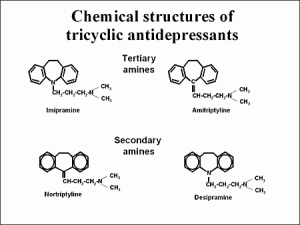Image: http://www.medscape.org
I recently wrote an article about Morgan Ingram, a 20-year-old woman who may or may not have committed suicide. Her death was caused by (as yet undetermined intentional/unintentional) amitriptyline intoxication. The case is still pending but it had me researching amitriptyline and its lethality when abused. Because TCAs rank so highly on the list of overdose agents, it is imperative that the pharmacokinetics of TCA overdose be reviewed.
Tricyclic antidepressants are the most widely used class of antidepressants. Although it is also among the oldest, with safer antidepressants now more widely available, doctors tend to prescribe TCAs with more frequency than any other class. This may be due to apparent cost advantage over other antidepressants as well as its high availability and proven efficiency. Perhaps due to this, TCAs have become an agent of notoriety in emergency departments across the globe in instances of intentional and accidental poisonings due to drug overdoses. It is counted as the 8th and 7th leading cause of toxicity in 2007 and 2008, respectively1. Amitriptyline is the most commonly abused TCA, followed by nortriptyline and doxepin2.
TCAs exert lethality by acting as sodium channel blockers4. They slow both the digestive process and absorption from the intestines and the heart until it stops beating. Death is usually officially achieved by retarded depolarization of the cardiac action potential2. These cardiac arrhythmias due to blockage of sodium and potassium channels usually develop in the first 2-6 hours of digestion3. Also, because it metabolizes slowly, onset of symptoms associated with toxicity occur most often 2 hours after ingestion3, with death occurring within 12 to 24 hours4. Although they slow the digestive processes, TCAs are rapidly absorbed from the gastrointestinal tract but may be delayed in some cases due to inhibition of gastric emptying. Intentional overdoses may sometimes be accompanied by an antiemetic drug to reduce gastric discomfort.
6 grams of a TCA is considered lethal. Self-poisoning with a “cocktail” of 6 grams amitriptyline, 300 mg benzodiazepine, and an antiemetic drug is fairly common as reported by medical examiners and emergency room departments. Unbound tricyclics may increase if acidosis occurs due to respiratory distress3. After ingestion, TCA metabolites are conjugated in the liver via first pass metabolism utilizing glucuronic acid and excreted by the kidneys.
Impulsive suicides in persons who generally have not exhibited prior psychiatric disorder are commonly motivated by anger, the desire to “get even,” the wish to frighten or punish others, or the need to avoid intense shame3. Suicide attempts by drug overdose is greater than women than in men and is most prevalent in persons aged 20-29 years3.
People who usually attempt suicide by TCA intoxication find time to death exceptionally long (36 hours) and may change their minds. In cases where rescue was successful, overdose patients complained of sinus tachycardia4. Labored breathing, low blood pressure, shock, enlarged pupils, coma, agitation, hallucinations, muscle rigidity, convulsions, and agonal breathing were also reported. If you suspect someone may be suffering some a TCA overdose, contact 911 and the National Poison Control Center at 1-800-222-1222 immediately to ensure the best outcome of survival.
References:
- Suicide attempts involving amitriptyline in adults: a prospective, demographic, clinical study
Turk J Med. Sci.
2011; 41(2): 243-249
- Tricyclic antidepressant toxicity in emergency medicine
Vivian Teal
Emedicine.medscape.com
- Guide to a Humane Self-Chosen Death
Dr. Peter Admiraal
- Tricyclic antidepressant overdose: a review
G.W. Kerr, A.C. McGuffie, S.W. Willkie
Dr. Kerr: gary.kerr@aaaht.scot.mhs.uk
Emerg.Med.J 2011; 18, 236-241
Emj.bmj.com/content/18/4/236

